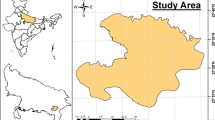Abstract
Sustainable groundwater aquifers are critical in arid and semiarid countries due to the scarcity of surface water and precipitation. Management of groundwater resources requires estimation of aquifer properties and interaction between multilayers in heterogeneous aquifers. A three-dimensional groundwater flow model was implemented to simulate a complex multilayer aquifer in Oman. Steady-state model was calibrated using groundwater level data in July 2016. Both the automated parameter calibration technique and manual trial and error method were applied for calibrating hydraulic conductivity, groundwater recharge, and anisotropy of soil layers. The optimum set of parameters of 14 observation wells was obtained from the simulation with minimum root mean square error of 0.8 m for groundwater water level. The calibrated model was validated using measured data for October 2016, and root mean square error was found to be 0.81 m for groundwater water level. Among the observation wells which were used in the above analysis, 4 of them were directed to different aquifer depths and each two observation wells were in the same location. These two sets of wells, therefore, were used for analyzing interactions among different aquifer layers. Results showed that increased pumping rates enhanced water transfer between multilayers due to increased hydraulic gradient. The effect was more dominant in layers with high vertical hydraulic conductivity. Also, the sensitivity analysis was performed and results indicated that the predicted water level was less sensitive to vertical anisotropy. The findings of this study could be useful for decision-makers for better management of groundwater resources in arid regions.



Source: Google Earth Pro









Similar content being viewed by others
Data availability
The following data used during the study are proprietary for MRMWR and PAW (Observation well data, rainfall data, pumping well data, and borehole data) and may only be provided by them.
References
Akbarpour S, Niksokhan M (2018) Investigating effects of climate change, urbanization, and sea level changes on groundwater resources in a coastal aquifer: an integrated assessment. Environ Monit Assess 190(579):1–16
Al-Lawati A (1997) Groundwater recharge in the upper catchment of Wadi Samail. Msc Thesis,Flinders University of South Australia
Al-Maktoumi A, El-Rawy M, Zekri S (2016) Management options for a multipurpose coastal aquifer in Oman. Arab J Geosci 9:1–14
Amerjeed MM (2016) Groundwater flow modeling with emphasis on recharge estimation in hardrock-alluvium Al-Fara catchment, Oman: comparison of WTF, CMB and modeling methods. Ph.D. Thesis, Sultan Qaboos University
Barlow PM, Leake SA (2012) Streamflow depletion by wells—understanding and managing the effects of groundwater pumping on streamflow. US Geological Survey Circular, 1376
Chitrakar P, Sana A (2015) Groundwater flow and solute transport simulation in eastern Al Batinah coastal plain Oman: case study. J Hydrol Eng 21(2):05015020
Dewandel BI, Lachassagne P, Boudier FO, Al-Hattali S, Ladouche B, Pinault J-L, Al-Suleimani Z (2005) A conceptual hydrogeological model of ophiolite hard-rock aquifers in Oman based on a multiscale and a multidisciplinary approach. Hydrogeol J 13:708–726
Di Maio R, Fabbrocino S, Forte G, Piegari E (2014) A three-dimensional hydrogeological–geophysical model of a multi-layered aquifer in the coastal alluvial plain of Sarno River (southern Italy). Hydrogeol J 2014(22):691–703
Ebrahim G, Jonoski A, Al-Maktoumi AP, Ahmed M, Mynett A (2016) Simulation-optimization approach for evaluating the feasibility of managed aquifer recharge in the Samail Lower Catchment, Oman. J Water Resour Plan Manag 142(2):05015007
Ezzeldin M, El-Alfy K, Abdel-Gawad H, Abd-Elmaboud M (2018) Comparison between structured and unstructured MODFLOW for simulating groundwater flow in three-dimensional multilayer quaternary aquifer of East Nile Delta, Egypt. Hydrol Curr Res 9:297
Guo W, Coulibaly K, Maliva GR (2015) Simulated effects of aquifer heterogeneity on ASR system performance. Environ Earth Sci. https://doi.org/10.1007/s12665-014-3822-4
Huyakorn P, Jones G, Andersen P (1986) Finite element algorithms for simulating three-dimensional groundwater flow and solute transport in multilayer systems. Water Resour Res 22:361–374
Izady A, Abdalla O, Joodavi A, Chen M (2017) Groundwater modeling and sustainability of a transboundary hardrock–alluvium aquifer in North Oman mountains. Water 9:161
McDonald MG, Harbaugh AW (1988) A modular three-dimensional finite-difference ground-water flow model. U.S.Geological Survey report, 83–875, 1-539
Neville C, Tonkin M (2004) Modeling multiaquifer wells with MOFLOW. Groundwater 42(6):910–919
Rabbani M, Warner J (1997) A finite-element linked model for analysis of solute transport in 3-D space of multilayer subsurface systems. J Hydrol 199:163–182
Rotiroti M, McArthur J, Fumagalli L, Stefania GA, Sacchi E, Bonomi T (2017) Pollutant sources in an arsenic-affected multilayer aquifer in the Po plain of Italy: implications for drinking-water supply. Sci Total Environ 578:502–512
Seneviratne A (2007) Development of steady state groundwater flow model in lower Walawa Basin SriLanka. Thesis
Wang Y, Zhang M-S, Hu F-S, Dong Y, Yu K (2018) A coupled one-dimensional numerical simulation of the land subsidence process in a multilayer aquifer system due to hydraulic head variation in the pumped layer. Geofluids. https://doi.org/10.1155/2018/4083439
Acknowledgements
The authors would like to express thanks to the Ministry of Regional Municipalities and Water Resources (MRMWR) and Public Authority of Water (PAW) for their continuous support by providing data for the research. Also, to co-authors for their productive comments.
Author information
Authors and Affiliations
Corresponding author
Additional information
Editorial responsibility: M. Abbaspour.
Rights and permissions
About this article
Cite this article
Al-Hashmi, S., Gunawardhana, L., Sana, A. et al. Application of groundwater flow model in assessing aquifer layers interaction in arid catchment area. Int. J. Environ. Sci. Technol. 17, 4577–4588 (2020). https://doi.org/10.1007/s13762-020-02805-x
Received:
Revised:
Accepted:
Published:
Issue Date:
DOI: https://doi.org/10.1007/s13762-020-02805-x




